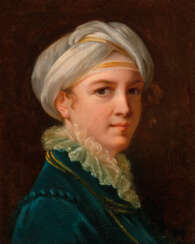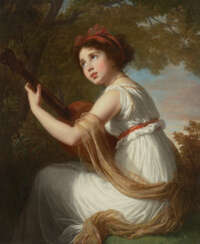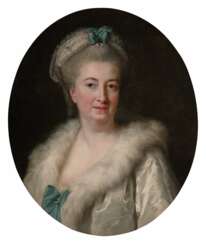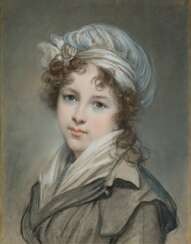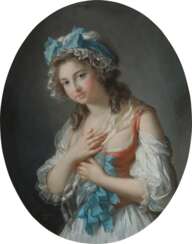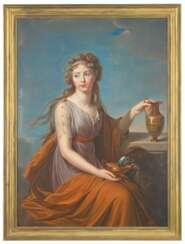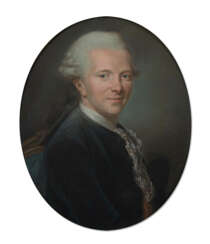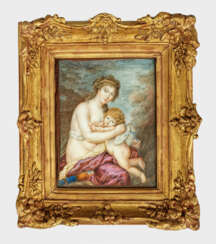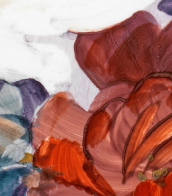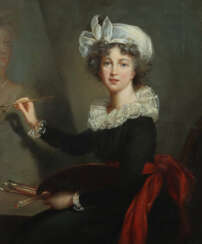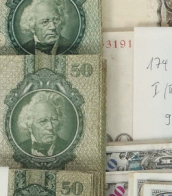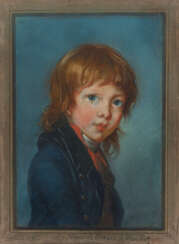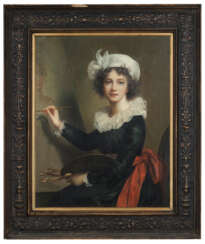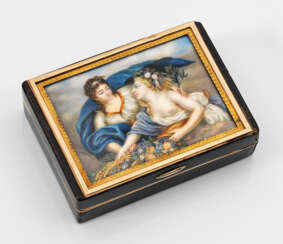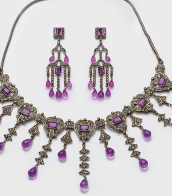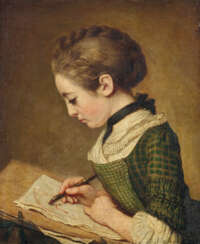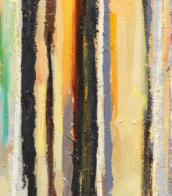élisabeth vigée le brun (1755 - 1842)

Elisabeth Vigee Le Brun was a celebrated French painter, renowned for her skill in portrait painting during the late 18th and early 19th centuries. Born in Paris in 1755, Vigee Le Brun's artistic talent was evident from a young age, leading her to become one of the most successful female artists of her time. Her father, a portraitist himself, was a significant influence on her early artistic development.
Vigee Le Brun is perhaps best known for her association with Queen Marie Antoinette. She painted more than 30 portraits of the queen, capturing her in a light that combined personal intimacy with the regal dignity required of royal portraiture. Her ability to portray her subjects with both elegance and psychological depth won her acclaim and patronage from the highest ranks of society across Europe.
Her career spanned one of Europe's most turbulent periods, including the French Revolution, which forced her into exile. During her years abroad, she lived and worked in major cultural centers such as Rome, Vienna, and St. Petersburg, further cementing her reputation among European aristocracy.
Vigee Le Brun's works are displayed in prestigious museums worldwide, including the Metropolitan Museum of Art in New York and the Louvre in Paris. Her legacy is not only in her portraits but also in her memoirs, which provide a vivid account of the cultural atmosphere of her time and her encounters with various historical figures.
For updates related to Elisabeth Vigee Le Brun, including new product sales and auction events featuring her work, consider signing up for updates. This subscription ensures you are informed about the latest developments and opportunities to appreciate or acquire works by this influential artist.
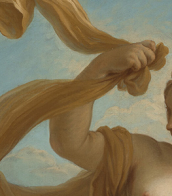

Elisabeth Vigee Le Brun was a celebrated French painter, renowned for her skill in portrait painting during the late 18th and early 19th centuries. Born in Paris in 1755, Vigee Le Brun's artistic talent was evident from a young age, leading her to become one of the most successful female artists of her time. Her father, a portraitist himself, was a significant influence on her early artistic development.
Vigee Le Brun is perhaps best known for her association with Queen Marie Antoinette. She painted more than 30 portraits of the queen, capturing her in a light that combined personal intimacy with the regal dignity required of royal portraiture. Her ability to portray her subjects with both elegance and psychological depth won her acclaim and patronage from the highest ranks of society across Europe.
Her career spanned one of Europe's most turbulent periods, including the French Revolution, which forced her into exile. During her years abroad, she lived and worked in major cultural centers such as Rome, Vienna, and St. Petersburg, further cementing her reputation among European aristocracy.
Vigee Le Brun's works are displayed in prestigious museums worldwide, including the Metropolitan Museum of Art in New York and the Louvre in Paris. Her legacy is not only in her portraits but also in her memoirs, which provide a vivid account of the cultural atmosphere of her time and her encounters with various historical figures.
For updates related to Elisabeth Vigee Le Brun, including new product sales and auction events featuring her work, consider signing up for updates. This subscription ensures you are informed about the latest developments and opportunities to appreciate or acquire works by this influential artist.
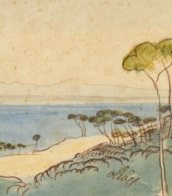

Elisabeth Vigee Le Brun was a celebrated French painter, renowned for her skill in portrait painting during the late 18th and early 19th centuries. Born in Paris in 1755, Vigee Le Brun's artistic talent was evident from a young age, leading her to become one of the most successful female artists of her time. Her father, a portraitist himself, was a significant influence on her early artistic development.
Vigee Le Brun is perhaps best known for her association with Queen Marie Antoinette. She painted more than 30 portraits of the queen, capturing her in a light that combined personal intimacy with the regal dignity required of royal portraiture. Her ability to portray her subjects with both elegance and psychological depth won her acclaim and patronage from the highest ranks of society across Europe.
Her career spanned one of Europe's most turbulent periods, including the French Revolution, which forced her into exile. During her years abroad, she lived and worked in major cultural centers such as Rome, Vienna, and St. Petersburg, further cementing her reputation among European aristocracy.
Vigee Le Brun's works are displayed in prestigious museums worldwide, including the Metropolitan Museum of Art in New York and the Louvre in Paris. Her legacy is not only in her portraits but also in her memoirs, which provide a vivid account of the cultural atmosphere of her time and her encounters with various historical figures.
For updates related to Elisabeth Vigee Le Brun, including new product sales and auction events featuring her work, consider signing up for updates. This subscription ensures you are informed about the latest developments and opportunities to appreciate or acquire works by this influential artist.
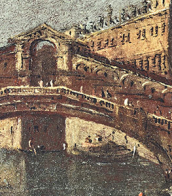

Elisabeth Vigee Le Brun was a celebrated French painter, renowned for her skill in portrait painting during the late 18th and early 19th centuries. Born in Paris in 1755, Vigee Le Brun's artistic talent was evident from a young age, leading her to become one of the most successful female artists of her time. Her father, a portraitist himself, was a significant influence on her early artistic development.
Vigee Le Brun is perhaps best known for her association with Queen Marie Antoinette. She painted more than 30 portraits of the queen, capturing her in a light that combined personal intimacy with the regal dignity required of royal portraiture. Her ability to portray her subjects with both elegance and psychological depth won her acclaim and patronage from the highest ranks of society across Europe.
Her career spanned one of Europe's most turbulent periods, including the French Revolution, which forced her into exile. During her years abroad, she lived and worked in major cultural centers such as Rome, Vienna, and St. Petersburg, further cementing her reputation among European aristocracy.
Vigee Le Brun's works are displayed in prestigious museums worldwide, including the Metropolitan Museum of Art in New York and the Louvre in Paris. Her legacy is not only in her portraits but also in her memoirs, which provide a vivid account of the cultural atmosphere of her time and her encounters with various historical figures.
For updates related to Elisabeth Vigee Le Brun, including new product sales and auction events featuring her work, consider signing up for updates. This subscription ensures you are informed about the latest developments and opportunities to appreciate or acquire works by this influential artist.
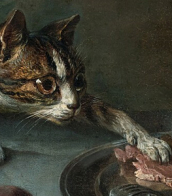

Elisabeth Vigee Le Brun was a celebrated French painter, renowned for her skill in portrait painting during the late 18th and early 19th centuries. Born in Paris in 1755, Vigee Le Brun's artistic talent was evident from a young age, leading her to become one of the most successful female artists of her time. Her father, a portraitist himself, was a significant influence on her early artistic development.
Vigee Le Brun is perhaps best known for her association with Queen Marie Antoinette. She painted more than 30 portraits of the queen, capturing her in a light that combined personal intimacy with the regal dignity required of royal portraiture. Her ability to portray her subjects with both elegance and psychological depth won her acclaim and patronage from the highest ranks of society across Europe.
Her career spanned one of Europe's most turbulent periods, including the French Revolution, which forced her into exile. During her years abroad, she lived and worked in major cultural centers such as Rome, Vienna, and St. Petersburg, further cementing her reputation among European aristocracy.
Vigee Le Brun's works are displayed in prestigious museums worldwide, including the Metropolitan Museum of Art in New York and the Louvre in Paris. Her legacy is not only in her portraits but also in her memoirs, which provide a vivid account of the cultural atmosphere of her time and her encounters with various historical figures.
For updates related to Elisabeth Vigee Le Brun, including new product sales and auction events featuring her work, consider signing up for updates. This subscription ensures you are informed about the latest developments and opportunities to appreciate or acquire works by this influential artist.


Elisabeth Vigee Le Brun was a celebrated French painter, renowned for her skill in portrait painting during the late 18th and early 19th centuries. Born in Paris in 1755, Vigee Le Brun's artistic talent was evident from a young age, leading her to become one of the most successful female artists of her time. Her father, a portraitist himself, was a significant influence on her early artistic development.
Vigee Le Brun is perhaps best known for her association with Queen Marie Antoinette. She painted more than 30 portraits of the queen, capturing her in a light that combined personal intimacy with the regal dignity required of royal portraiture. Her ability to portray her subjects with both elegance and psychological depth won her acclaim and patronage from the highest ranks of society across Europe.
Her career spanned one of Europe's most turbulent periods, including the French Revolution, which forced her into exile. During her years abroad, she lived and worked in major cultural centers such as Rome, Vienna, and St. Petersburg, further cementing her reputation among European aristocracy.
Vigee Le Brun's works are displayed in prestigious museums worldwide, including the Metropolitan Museum of Art in New York and the Louvre in Paris. Her legacy is not only in her portraits but also in her memoirs, which provide a vivid account of the cultural atmosphere of her time and her encounters with various historical figures.
For updates related to Elisabeth Vigee Le Brun, including new product sales and auction events featuring her work, consider signing up for updates. This subscription ensures you are informed about the latest developments and opportunities to appreciate or acquire works by this influential artist.


Elisabeth Vigee Le Brun was a celebrated French painter, renowned for her skill in portrait painting during the late 18th and early 19th centuries. Born in Paris in 1755, Vigee Le Brun's artistic talent was evident from a young age, leading her to become one of the most successful female artists of her time. Her father, a portraitist himself, was a significant influence on her early artistic development.
Vigee Le Brun is perhaps best known for her association with Queen Marie Antoinette. She painted more than 30 portraits of the queen, capturing her in a light that combined personal intimacy with the regal dignity required of royal portraiture. Her ability to portray her subjects with both elegance and psychological depth won her acclaim and patronage from the highest ranks of society across Europe.
Her career spanned one of Europe's most turbulent periods, including the French Revolution, which forced her into exile. During her years abroad, she lived and worked in major cultural centers such as Rome, Vienna, and St. Petersburg, further cementing her reputation among European aristocracy.
Vigee Le Brun's works are displayed in prestigious museums worldwide, including the Metropolitan Museum of Art in New York and the Louvre in Paris. Her legacy is not only in her portraits but also in her memoirs, which provide a vivid account of the cultural atmosphere of her time and her encounters with various historical figures.
For updates related to Elisabeth Vigee Le Brun, including new product sales and auction events featuring her work, consider signing up for updates. This subscription ensures you are informed about the latest developments and opportunities to appreciate or acquire works by this influential artist.


Elisabeth Vigee Le Brun was a celebrated French painter, renowned for her skill in portrait painting during the late 18th and early 19th centuries. Born in Paris in 1755, Vigee Le Brun's artistic talent was evident from a young age, leading her to become one of the most successful female artists of her time. Her father, a portraitist himself, was a significant influence on her early artistic development.
Vigee Le Brun is perhaps best known for her association with Queen Marie Antoinette. She painted more than 30 portraits of the queen, capturing her in a light that combined personal intimacy with the regal dignity required of royal portraiture. Her ability to portray her subjects with both elegance and psychological depth won her acclaim and patronage from the highest ranks of society across Europe.
Her career spanned one of Europe's most turbulent periods, including the French Revolution, which forced her into exile. During her years abroad, she lived and worked in major cultural centers such as Rome, Vienna, and St. Petersburg, further cementing her reputation among European aristocracy.
Vigee Le Brun's works are displayed in prestigious museums worldwide, including the Metropolitan Museum of Art in New York and the Louvre in Paris. Her legacy is not only in her portraits but also in her memoirs, which provide a vivid account of the cultural atmosphere of her time and her encounters with various historical figures.
For updates related to Elisabeth Vigee Le Brun, including new product sales and auction events featuring her work, consider signing up for updates. This subscription ensures you are informed about the latest developments and opportunities to appreciate or acquire works by this influential artist.


Elisabeth Vigee Le Brun was a celebrated French painter, renowned for her skill in portrait painting during the late 18th and early 19th centuries. Born in Paris in 1755, Vigee Le Brun's artistic talent was evident from a young age, leading her to become one of the most successful female artists of her time. Her father, a portraitist himself, was a significant influence on her early artistic development.
Vigee Le Brun is perhaps best known for her association with Queen Marie Antoinette. She painted more than 30 portraits of the queen, capturing her in a light that combined personal intimacy with the regal dignity required of royal portraiture. Her ability to portray her subjects with both elegance and psychological depth won her acclaim and patronage from the highest ranks of society across Europe.
Her career spanned one of Europe's most turbulent periods, including the French Revolution, which forced her into exile. During her years abroad, she lived and worked in major cultural centers such as Rome, Vienna, and St. Petersburg, further cementing her reputation among European aristocracy.
Vigee Le Brun's works are displayed in prestigious museums worldwide, including the Metropolitan Museum of Art in New York and the Louvre in Paris. Her legacy is not only in her portraits but also in her memoirs, which provide a vivid account of the cultural atmosphere of her time and her encounters with various historical figures.
For updates related to Elisabeth Vigee Le Brun, including new product sales and auction events featuring her work, consider signing up for updates. This subscription ensures you are informed about the latest developments and opportunities to appreciate or acquire works by this influential artist.


Elisabeth Vigee Le Brun was a celebrated French painter, renowned for her skill in portrait painting during the late 18th and early 19th centuries. Born in Paris in 1755, Vigee Le Brun's artistic talent was evident from a young age, leading her to become one of the most successful female artists of her time. Her father, a portraitist himself, was a significant influence on her early artistic development.
Vigee Le Brun is perhaps best known for her association with Queen Marie Antoinette. She painted more than 30 portraits of the queen, capturing her in a light that combined personal intimacy with the regal dignity required of royal portraiture. Her ability to portray her subjects with both elegance and psychological depth won her acclaim and patronage from the highest ranks of society across Europe.
Her career spanned one of Europe's most turbulent periods, including the French Revolution, which forced her into exile. During her years abroad, she lived and worked in major cultural centers such as Rome, Vienna, and St. Petersburg, further cementing her reputation among European aristocracy.
Vigee Le Brun's works are displayed in prestigious museums worldwide, including the Metropolitan Museum of Art in New York and the Louvre in Paris. Her legacy is not only in her portraits but also in her memoirs, which provide a vivid account of the cultural atmosphere of her time and her encounters with various historical figures.
For updates related to Elisabeth Vigee Le Brun, including new product sales and auction events featuring her work, consider signing up for updates. This subscription ensures you are informed about the latest developments and opportunities to appreciate or acquire works by this influential artist.


Elisabeth Vigee Le Brun was a celebrated French painter, renowned for her skill in portrait painting during the late 18th and early 19th centuries. Born in Paris in 1755, Vigee Le Brun's artistic talent was evident from a young age, leading her to become one of the most successful female artists of her time. Her father, a portraitist himself, was a significant influence on her early artistic development.
Vigee Le Brun is perhaps best known for her association with Queen Marie Antoinette. She painted more than 30 portraits of the queen, capturing her in a light that combined personal intimacy with the regal dignity required of royal portraiture. Her ability to portray her subjects with both elegance and psychological depth won her acclaim and patronage from the highest ranks of society across Europe.
Her career spanned one of Europe's most turbulent periods, including the French Revolution, which forced her into exile. During her years abroad, she lived and worked in major cultural centers such as Rome, Vienna, and St. Petersburg, further cementing her reputation among European aristocracy.
Vigee Le Brun's works are displayed in prestigious museums worldwide, including the Metropolitan Museum of Art in New York and the Louvre in Paris. Her legacy is not only in her portraits but also in her memoirs, which provide a vivid account of the cultural atmosphere of her time and her encounters with various historical figures.
For updates related to Elisabeth Vigee Le Brun, including new product sales and auction events featuring her work, consider signing up for updates. This subscription ensures you are informed about the latest developments and opportunities to appreciate or acquire works by this influential artist.


Elisabeth Vigee Le Brun was a celebrated French painter, renowned for her skill in portrait painting during the late 18th and early 19th centuries. Born in Paris in 1755, Vigee Le Brun's artistic talent was evident from a young age, leading her to become one of the most successful female artists of her time. Her father, a portraitist himself, was a significant influence on her early artistic development.
Vigee Le Brun is perhaps best known for her association with Queen Marie Antoinette. She painted more than 30 portraits of the queen, capturing her in a light that combined personal intimacy with the regal dignity required of royal portraiture. Her ability to portray her subjects with both elegance and psychological depth won her acclaim and patronage from the highest ranks of society across Europe.
Her career spanned one of Europe's most turbulent periods, including the French Revolution, which forced her into exile. During her years abroad, she lived and worked in major cultural centers such as Rome, Vienna, and St. Petersburg, further cementing her reputation among European aristocracy.
Vigee Le Brun's works are displayed in prestigious museums worldwide, including the Metropolitan Museum of Art in New York and the Louvre in Paris. Her legacy is not only in her portraits but also in her memoirs, which provide a vivid account of the cultural atmosphere of her time and her encounters with various historical figures.
For updates related to Elisabeth Vigee Le Brun, including new product sales and auction events featuring her work, consider signing up for updates. This subscription ensures you are informed about the latest developments and opportunities to appreciate or acquire works by this influential artist.


Elisabeth Vigee Le Brun was a celebrated French painter, renowned for her skill in portrait painting during the late 18th and early 19th centuries. Born in Paris in 1755, Vigee Le Brun's artistic talent was evident from a young age, leading her to become one of the most successful female artists of her time. Her father, a portraitist himself, was a significant influence on her early artistic development.
Vigee Le Brun is perhaps best known for her association with Queen Marie Antoinette. She painted more than 30 portraits of the queen, capturing her in a light that combined personal intimacy with the regal dignity required of royal portraiture. Her ability to portray her subjects with both elegance and psychological depth won her acclaim and patronage from the highest ranks of society across Europe.
Her career spanned one of Europe's most turbulent periods, including the French Revolution, which forced her into exile. During her years abroad, she lived and worked in major cultural centers such as Rome, Vienna, and St. Petersburg, further cementing her reputation among European aristocracy.
Vigee Le Brun's works are displayed in prestigious museums worldwide, including the Metropolitan Museum of Art in New York and the Louvre in Paris. Her legacy is not only in her portraits but also in her memoirs, which provide a vivid account of the cultural atmosphere of her time and her encounters with various historical figures.
For updates related to Elisabeth Vigee Le Brun, including new product sales and auction events featuring her work, consider signing up for updates. This subscription ensures you are informed about the latest developments and opportunities to appreciate or acquire works by this influential artist.


Elisabeth Vigee Le Brun was a celebrated French painter, renowned for her skill in portrait painting during the late 18th and early 19th centuries. Born in Paris in 1755, Vigee Le Brun's artistic talent was evident from a young age, leading her to become one of the most successful female artists of her time. Her father, a portraitist himself, was a significant influence on her early artistic development.
Vigee Le Brun is perhaps best known for her association with Queen Marie Antoinette. She painted more than 30 portraits of the queen, capturing her in a light that combined personal intimacy with the regal dignity required of royal portraiture. Her ability to portray her subjects with both elegance and psychological depth won her acclaim and patronage from the highest ranks of society across Europe.
Her career spanned one of Europe's most turbulent periods, including the French Revolution, which forced her into exile. During her years abroad, she lived and worked in major cultural centers such as Rome, Vienna, and St. Petersburg, further cementing her reputation among European aristocracy.
Vigee Le Brun's works are displayed in prestigious museums worldwide, including the Metropolitan Museum of Art in New York and the Louvre in Paris. Her legacy is not only in her portraits but also in her memoirs, which provide a vivid account of the cultural atmosphere of her time and her encounters with various historical figures.
For updates related to Elisabeth Vigee Le Brun, including new product sales and auction events featuring her work, consider signing up for updates. This subscription ensures you are informed about the latest developments and opportunities to appreciate or acquire works by this influential artist.


Elisabeth Vigee Le Brun was a celebrated French painter, renowned for her skill in portrait painting during the late 18th and early 19th centuries. Born in Paris in 1755, Vigee Le Brun's artistic talent was evident from a young age, leading her to become one of the most successful female artists of her time. Her father, a portraitist himself, was a significant influence on her early artistic development.
Vigee Le Brun is perhaps best known for her association with Queen Marie Antoinette. She painted more than 30 portraits of the queen, capturing her in a light that combined personal intimacy with the regal dignity required of royal portraiture. Her ability to portray her subjects with both elegance and psychological depth won her acclaim and patronage from the highest ranks of society across Europe.
Her career spanned one of Europe's most turbulent periods, including the French Revolution, which forced her into exile. During her years abroad, she lived and worked in major cultural centers such as Rome, Vienna, and St. Petersburg, further cementing her reputation among European aristocracy.
Vigee Le Brun's works are displayed in prestigious museums worldwide, including the Metropolitan Museum of Art in New York and the Louvre in Paris. Her legacy is not only in her portraits but also in her memoirs, which provide a vivid account of the cultural atmosphere of her time and her encounters with various historical figures.
For updates related to Elisabeth Vigee Le Brun, including new product sales and auction events featuring her work, consider signing up for updates. This subscription ensures you are informed about the latest developments and opportunities to appreciate or acquire works by this influential artist.


Elisabeth Vigee Le Brun was a celebrated French painter, renowned for her skill in portrait painting during the late 18th and early 19th centuries. Born in Paris in 1755, Vigee Le Brun's artistic talent was evident from a young age, leading her to become one of the most successful female artists of her time. Her father, a portraitist himself, was a significant influence on her early artistic development.
Vigee Le Brun is perhaps best known for her association with Queen Marie Antoinette. She painted more than 30 portraits of the queen, capturing her in a light that combined personal intimacy with the regal dignity required of royal portraiture. Her ability to portray her subjects with both elegance and psychological depth won her acclaim and patronage from the highest ranks of society across Europe.
Her career spanned one of Europe's most turbulent periods, including the French Revolution, which forced her into exile. During her years abroad, she lived and worked in major cultural centers such as Rome, Vienna, and St. Petersburg, further cementing her reputation among European aristocracy.
Vigee Le Brun's works are displayed in prestigious museums worldwide, including the Metropolitan Museum of Art in New York and the Louvre in Paris. Her legacy is not only in her portraits but also in her memoirs, which provide a vivid account of the cultural atmosphere of her time and her encounters with various historical figures.
For updates related to Elisabeth Vigee Le Brun, including new product sales and auction events featuring her work, consider signing up for updates. This subscription ensures you are informed about the latest developments and opportunities to appreciate or acquire works by this influential artist.
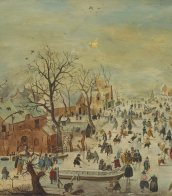

Elisabeth Vigee Le Brun was a celebrated French painter, renowned for her skill in portrait painting during the late 18th and early 19th centuries. Born in Paris in 1755, Vigee Le Brun's artistic talent was evident from a young age, leading her to become one of the most successful female artists of her time. Her father, a portraitist himself, was a significant influence on her early artistic development.
Vigee Le Brun is perhaps best known for her association with Queen Marie Antoinette. She painted more than 30 portraits of the queen, capturing her in a light that combined personal intimacy with the regal dignity required of royal portraiture. Her ability to portray her subjects with both elegance and psychological depth won her acclaim and patronage from the highest ranks of society across Europe.
Her career spanned one of Europe's most turbulent periods, including the French Revolution, which forced her into exile. During her years abroad, she lived and worked in major cultural centers such as Rome, Vienna, and St. Petersburg, further cementing her reputation among European aristocracy.
Vigee Le Brun's works are displayed in prestigious museums worldwide, including the Metropolitan Museum of Art in New York and the Louvre in Paris. Her legacy is not only in her portraits but also in her memoirs, which provide a vivid account of the cultural atmosphere of her time and her encounters with various historical figures.
For updates related to Elisabeth Vigee Le Brun, including new product sales and auction events featuring her work, consider signing up for updates. This subscription ensures you are informed about the latest developments and opportunities to appreciate or acquire works by this influential artist.


Elisabeth Vigee Le Brun was a celebrated French painter, renowned for her skill in portrait painting during the late 18th and early 19th centuries. Born in Paris in 1755, Vigee Le Brun's artistic talent was evident from a young age, leading her to become one of the most successful female artists of her time. Her father, a portraitist himself, was a significant influence on her early artistic development.
Vigee Le Brun is perhaps best known for her association with Queen Marie Antoinette. She painted more than 30 portraits of the queen, capturing her in a light that combined personal intimacy with the regal dignity required of royal portraiture. Her ability to portray her subjects with both elegance and psychological depth won her acclaim and patronage from the highest ranks of society across Europe.
Her career spanned one of Europe's most turbulent periods, including the French Revolution, which forced her into exile. During her years abroad, she lived and worked in major cultural centers such as Rome, Vienna, and St. Petersburg, further cementing her reputation among European aristocracy.
Vigee Le Brun's works are displayed in prestigious museums worldwide, including the Metropolitan Museum of Art in New York and the Louvre in Paris. Her legacy is not only in her portraits but also in her memoirs, which provide a vivid account of the cultural atmosphere of her time and her encounters with various historical figures.
For updates related to Elisabeth Vigee Le Brun, including new product sales and auction events featuring her work, consider signing up for updates. This subscription ensures you are informed about the latest developments and opportunities to appreciate or acquire works by this influential artist.


Elisabeth Vigee Le Brun was a celebrated French painter, renowned for her skill in portrait painting during the late 18th and early 19th centuries. Born in Paris in 1755, Vigee Le Brun's artistic talent was evident from a young age, leading her to become one of the most successful female artists of her time. Her father, a portraitist himself, was a significant influence on her early artistic development.
Vigee Le Brun is perhaps best known for her association with Queen Marie Antoinette. She painted more than 30 portraits of the queen, capturing her in a light that combined personal intimacy with the regal dignity required of royal portraiture. Her ability to portray her subjects with both elegance and psychological depth won her acclaim and patronage from the highest ranks of society across Europe.
Her career spanned one of Europe's most turbulent periods, including the French Revolution, which forced her into exile. During her years abroad, she lived and worked in major cultural centers such as Rome, Vienna, and St. Petersburg, further cementing her reputation among European aristocracy.
Vigee Le Brun's works are displayed in prestigious museums worldwide, including the Metropolitan Museum of Art in New York and the Louvre in Paris. Her legacy is not only in her portraits but also in her memoirs, which provide a vivid account of the cultural atmosphere of her time and her encounters with various historical figures.
For updates related to Elisabeth Vigee Le Brun, including new product sales and auction events featuring her work, consider signing up for updates. This subscription ensures you are informed about the latest developments and opportunities to appreciate or acquire works by this influential artist.
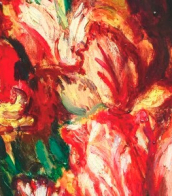

Elisabeth Vigee Le Brun was a celebrated French painter, renowned for her skill in portrait painting during the late 18th and early 19th centuries. Born in Paris in 1755, Vigee Le Brun's artistic talent was evident from a young age, leading her to become one of the most successful female artists of her time. Her father, a portraitist himself, was a significant influence on her early artistic development.
Vigee Le Brun is perhaps best known for her association with Queen Marie Antoinette. She painted more than 30 portraits of the queen, capturing her in a light that combined personal intimacy with the regal dignity required of royal portraiture. Her ability to portray her subjects with both elegance and psychological depth won her acclaim and patronage from the highest ranks of society across Europe.
Her career spanned one of Europe's most turbulent periods, including the French Revolution, which forced her into exile. During her years abroad, she lived and worked in major cultural centers such as Rome, Vienna, and St. Petersburg, further cementing her reputation among European aristocracy.
Vigee Le Brun's works are displayed in prestigious museums worldwide, including the Metropolitan Museum of Art in New York and the Louvre in Paris. Her legacy is not only in her portraits but also in her memoirs, which provide a vivid account of the cultural atmosphere of her time and her encounters with various historical figures.
For updates related to Elisabeth Vigee Le Brun, including new product sales and auction events featuring her work, consider signing up for updates. This subscription ensures you are informed about the latest developments and opportunities to appreciate or acquire works by this influential artist.
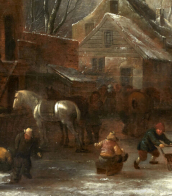

Anne Vallayer-Coster was a renowned French artist, celebrated for her exceptional still-life paintings that captivated 18th-century art enthusiasts, including the French Queen Marie Antoinette. Born into an artistic family in 1744, Vallayer-Coster's talent was evident early on, leading to her unanimous election into the prestigious Académie Royale at just 26 years old. Her works, characterized by their vibrant color, meticulous detail, and textural precision, often depicted bowls of fruit, game, shells, and flowers, showcasing the opulence of French aristocracy before the Revolution.
Vallayer-Coster's career was notable not only for her artistic achievements but also for her ability to navigate the male-dominated art world of her time. Despite the societal constraints on women artists, she gained the patronage of influential figures like Marie Antoinette and was one of the few women admitted to the Royal Academy of Painting and Sculpture. Her work received critical acclaim at the Salon, where she exhibited regularly from 1771 until 1817, and her still-lifes were praised for their sensuality, illusionistic perfection, and the rich, indulgent luxury they portrayed.
One of Vallayer-Coster's most ambitious works, Still Life with Flowers in an Alabaster Vase and Fruit (1783), exemplifies her unparalleled skill in capturing the soft textures of flowers and their harmonious arrangement. This masterpiece was hailed as such at the Salon of 1783 and is considered by Vallayer-Coster herself as her finest painting. Lost for nearly two centuries, it was recently rediscovered in an almost pristine state and is now part of the National Gallery of Art's collection, highlighting Vallayer-Coster's significant contributions to European art history.
Throughout her career, Vallayer-Coster produced more than 120 still lifes, always with a distinctive brilliance in color, earning her a place among the elite artists of her time. Despite facing challenges during the French Revolution due to her close association with the monarchy, she continued to exhibit her work and contribute to the art world until her death in 1818.
For collectors and experts in art and antiques, Anne Vallayer-Coster's legacy is a testament to her skill, resilience, and the impact of her work on the history of art. To stay updated on new product sales and auction events related to Anne Vallayer-Coster, sign up for updates that focus solely on this exceptional artist's contributions to the art world.

